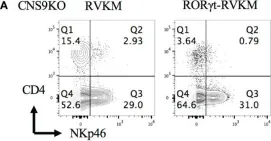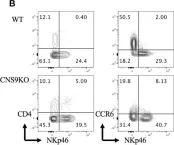Macrophage function is determined by microenvironment and origin. Brain and retinal microglia are both derived from yolk sac progenitors, yet their microenvironments differ. Utilizing single-cell RNA sequencing (scRNA-seq) data from mice, we tested the hypothesis that retinal and brain microglia exhibit distinct transcriptional profiles due to their unique microenvironments.
Eyes and brains from 2-4 month wildtype mice were combined (20 eyes; 3 brains) to yield one biologically diverse sample per organ. Each tissue was digested into single cell suspensions, enriched for immune cells, and sorted for scRNA-seq. Analysis was performed in Seurat v3 including clustering, integration, and differential expression. Multi-parameter flow cytometry was used for validation of scRNA-seq results. Lymphocytic choriomeningitis virus (LCMV) Clone 13, which produces a systemic, chronic, and neurotropic infection, was used to validate scRNA-seq and flow cytometry results in vivo.
Cluster analysis of integrated gene expression data from eye and brain identified 6 Tmem119 + P2ry12 + microglial clusters. Differential expression analysis revealed that eye microglia were enriched for more pro-inflammatory processes including antigen processing via MHC class I (14.0-fold, H2-D1 and H2-K1) and positive regulation of T-cell immunity (8.4-fold) compared to brain microglia. Multi-parameter flow cytometry confirmed that retinal microglia expressed 3.2-fold greater H2-Db and 263.3-fold more H2-Kb than brain microglia. On Day 13 and 29 after LCMV infection, CD8+ T-cell density was greater in the retina than the brain.
Our data demonstrate that the microenvironment of retina and brain differs, resulting in microglia-specific gene expression changes. Specifically, retinal microglia express greater MHC class I by scRNA-seq and multi-parameter flow cytometry, resulting in a possibly enhanced capability to stimulate CD8+ T-cell inflammation during LCMV infection. These results may explain tissue-specific differences between retina and brain during systemic viral infections and CD8+ T-cell driven autoimmune disease.
Copyright © 2024 Bloomfield, Gong, Droho, Makinde, Gurra, Stumpf, Kharel, Gadhvi, Winter, Cui, Cuda and Lavine.
Product Citations: 11
In Frontiers in Immunology on 27 May 2024 by Bloomfield, C. L., Gong, J., et al.
-
Mus musculus (House mouse)
-
Immunology and Microbiology
-
Neuroscience
Low-dose decitabine enhances the efficacy of viral cancer vaccines for immunotherapy.
In Molecular Therapy. Oncology on 21 March 2024 by Russo, S., Feola, S., et al.
Cancer immunotherapy requires a specific antitumor CD8+ T cell-driven immune response; however, upon genetic and epigenetic alterations of the antigen processing and presenting components, cancer cells escape the CD8+ T cell recognition. As a result, poorly immunogenic tumors are refractory to conventional immunotherapy. In this context, the use of viral cancer vaccines in combination with hypomethylating agents represents a promising strategy to prevent cancer from escaping immune system recognition. In this study, we evaluated the sensitivity of melanoma (B16-expressing ovalbumin) and metastatic triple-negative breast cancer (4T1) cell lines to FDA-approved low-dose decitabine in combination with PeptiCRAd, an adenoviral anticancer vaccine. The two models showed different sensitivity to decitabine in vitro and in vivo when combined with PeptiCRAd. In particular, mice bearing syngeneic 4T1 cancer showed higher tumor growth control when receiving the combinatorial treatment compared to single controls in association with a higher expression of MHC class I on cancer cells and reduction in Tregs within the tumor microenvironment. Furthermore, remodeling of the CD8+ T cell infiltration and cytotoxic activity toward cancer cells confirmed the effect of decitabine in enhancing anticancer vaccines in immunotherapy regimens.
© 2024 The Author(s).
-
FC/FACS
-
Mus musculus (House mouse)
-
Cancer Research
-
Immunology and Microbiology
CD11c+ macrophages are proangiogenic and necessary for experimental choroidal neovascularization.
In JCI Insight on 10 April 2023 by Droho, S., Rajesh, A., et al.
Patients with neovascular AMD (nAMD) suffer vision loss from destructive angiogenesis, termed choroidal neovascularization (CNV). Macrophages are found in CNV lesions from patients with nAMD. Additionally, Ccr2-/- mice, which lack classical monocyte-derived macrophages, show reduced CNV size. However, macrophages are highly diverse cells that can perform multiple functions. We performed single-cell RNA-Seq on immune cells from WT and Ccr2-/- eyes to uncover macrophage heterogeneity during the laser-induced CNV mouse model of nAMD. We identified 12 macrophage clusters, including Spp1+ macrophages. Spp1+ macrophages were enriched from WT lasered eyes and expressed a proangiogenic transcriptome via multiple pathways, including vascular endothelial growth factor signaling, endothelial cell sprouting, cytokine signaling, and fibrosis. Additionally, Spp1+ macrophages expressed the marker CD11c, and CD11c+ macrophages were increased by laser and present in CNV lesions. Finally, CD11c+ macrophage depletion reduced CNV size by 40%. These findings broaden our understanding of ocular macrophage heterogeneity and implicate CD11c+ macrophages as potential therapeutic targets for treatment-resistant patients with nAMD.
-
Mus musculus (House mouse)
A cis-element at the Rorc locus regulates the development of type 3 innate lymphoid cells.
In Frontiers in Immunology on 28 March 2023 by Chang, D., Zhang, H., et al.
As an important early source of IL-17A and IL-22 in immune responses, type 3 innate lymphoid cells (ILC3s) are critically regulated by the transcription factor retinoic-acid-receptor-related orphan receptor gamma t (RORγt). Previously, we have identified a crucial role of the conserved non-coding sequence 9 (CNS9), located at +5,802 to +7,963 bp of the Rorc gene, in directing T helper 17 differentiation and related autoimmune disease. However, whether cis-acting elements regulate RORγt expression in ILC3s is unknown.
Here we show that CNS9 deficiency in mice not only decreases ILC3 signature gene expression and increases ILC1-gene expression features in total ILC3s, but also leads to generation of a distinct CD4+NKp46+ ILC3 population, though the overall numbers and frequencies of RORγt+ ILC3s are not affected. Mechanistically, CNS9 deficiency selectively decreases RORγt expression in ILC3s, which thus alters ILC3 gene expression features and promotes cell-intrinsic generation of CD4+NKp46+ ILC3 subset.
Our study thus identifies CNS9 as an essential cis-regulatory element controlling the lineage stability and plasticity of ILC3s through modulating expression levels of RORγt protein.
Copyright © 2023 Chang, Zhang, Ge, Xing, Guo, Wang and Dong.
-
FC/FACS
-
Mus musculus (House mouse)
-
Immunology and Microbiology
Peptidylarginine Deiminase 2 in Murine Antiviral and Autoimmune Antibody Responses.
In Journal of Immunology Research on 28 January 2022 by Mergaert, A. M., Denny, M. F., et al.
The peptidylarginine deiminases (PADs) and the citrullinated proteins that they generate have key roles in innate immunity and rheumatoid arthritis, an inflammatory arthritis with antibodies that target citrullinated proteins. However, the importance of PADs, particularly PAD2, in the adaptive immune response, both normal and pathogenic, is newly emerging. In this study, we evaluated a requirement for PAD2 in the antibody response in collagen-induced arthritis (CIA), a T and B cell-driven murine model of rheumatoid arthritis, and in the protective antibody response to murine influenza infection. Using PAD2-/- and PAD2+/+ mice on the DBA/1J background, we found that PAD2 is required for maximal anti-collagen antibody levels, but not collagen-specific plasma cell numbers, T cell activation or polarization, or arthritis severity in CIA. Also, we found that PAD2 is required not just for normal levels of persistent hemagglutination inhibiting antibodies but also for full protection from lethal influenza rechallenge. Together, these data provide evidence for a novel modest requirement for PAD2 in a normal antiviral antibody response and in an abnormal autoantibody response in inflammatory arthritis.
Copyright © 2022 Aisha M. Mergaert et al.
-
Immunology and Microbiology
In Front Immunol on 28 March 2023 by Chang, D., Zhang, H., et al.
Fig.6.A

-
FC/FACS
-
Mus musculus (House mouse)
Collected and cropped from Front Immunol by CiteAb, provided under a CC-BY license
Image 1 of 3
In Front Immunol on 28 March 2023 by Chang, D., Zhang, H., et al.
Fig.2.C

-
FC/FACS
-
Mus musculus (House mouse)
Collected and cropped from Front Immunol by CiteAb, provided under a CC-BY license
Image 1 of 3
In Front Immunol on 28 March 2023 by Chang, D., Zhang, H., et al.
Fig.3.B

-
FC/FACS
-
Mus musculus (House mouse)
Collected and cropped from Front Immunol by CiteAb, provided under a CC-BY license
Image 1 of 3


